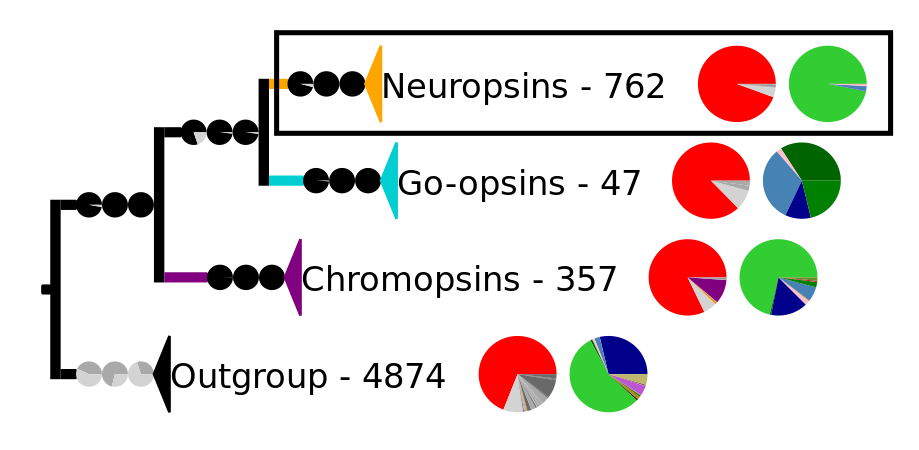OPN5
| OPN5 | |||
|---|---|---|---|
| Identifiers | |||
Gene ontology | |||
| Molecular function | |||
| Cellular component | |||
| Biological process | |||
| Sources:Amigo / QuickGO | |||
Ensembl | |||||||||
|---|---|---|---|---|---|---|---|---|---|
| UniProt | |||||||||
| RefSeq (mRNA) | |||||||||
| RefSeq (protein) | |||||||||
| Location (UCSC) | Chr 6: 47.78 – 47.83 Mb | Chr 17: 42.87 – 42.92 Mb | |||||||
| PubMed search | [3] | [4] | |||||||
| View/Edit Human | View/Edit Mouse |
Opsin-5, also known as G-protein coupled receptor 136 or neuropsin is a protein that in humans is encoded by the OPN5 gene. Opsin-5 is a member of the opsin subfamily of the G protein-coupled receptors.[5][6][7] It is a photoreceptor protein sensitive to ultraviolet (UV) light. The OPN5 gene was discovered in mouse and human genomes and its mRNA expression was also found in neural tissues. Neuropsin is bistable at 0 °C and activates a UV-sensitive, heterotrimeric G protein Gi-mediated pathway in mammalian and avian tissues.[8][9]
Function
Human neuropsin is expressed in the eye, brain, testes, and spinal cord. Neuropsin belongs to the seven-exon subfamily of mammalian opsin genes that includes
Photochemistry
When reconstituted with
Species distribution
Neuropsins are known from
Searches of publicly available databases of genetic sequences have found putative neuropsin orthologs in both major branches of
Phylogeny
The neuropsins are one of three subgroups of the tetraopsins (also known as RGR/Go or Group 4 opsins). The other groups are the chromopsins and the Go-opsins. The tetraopsins are one of the five major groups of the animal
-
Phylogenetic reconstruction of the opsins. The outgroup contains other G protein-coupled receptors. The frame highlights the tetraopsins, which are expanded in the next image.
-
Phylogenetic reconstruction of the tetraopsins. The outgroup contains other G protein-coupled receptors including the other opsins. The frame highlights the neuropsins, which are expanded in the next image.
In the
References
- ^ a b c GRCh38: Ensembl release 89: ENSG00000124818 – Ensembl, May 2017
- ^ a b c GRCm38: Ensembl release 89: ENSMUSG00000043972 – Ensembl, May 2017
- ^ "Human PubMed Reference:". National Center for Biotechnology Information, U.S. National Library of Medicine.
- ^ "Mouse PubMed Reference:". National Center for Biotechnology Information, U.S. National Library of Medicine.
- ^ S2CID 9577067.
- S2CID 11563502.
- ^ a b "Entrez Gene: OPN5 opsin 5".
- ^ PMID 22043319.
- ^ PMID 21135214.
- ^ PMID 25429842.
- ^ PMID 35954284..
 Material was copied and adapted from this source, which is available under a Creative Commons Attribution 4.0 International License
Material was copied and adapted from this source, which is available under a Creative Commons Attribution 4.0 International License - S2CID 42113764.
- PMID 20679218.
- ^ PMID 25193307.
- PMID 27166423.
- ^ PMID 27797948.
- PMID 22012981.
- PMID 26154478.
Further reading
- Terakita A (2005). "The opsins". Genome Biology. 6 (3): 213. PMID 15774036.
- Vassilatis DK, Hohmann JG, Zeng H, Li F, Ranchalis JE, Mortrud MT, Brown A, Rodriguez SS, Weller JR, Wright AC, Bergmann JE, Gaitanaris GA (Apr 2003). "The G protein-coupled receptor repertoires of human and mouse". Proceedings of the National Academy of Sciences of the United States of America. 100 (8): 4903–8. PMID 12679517.
This article incorporates text from the United States National Library of Medicine, which is in the public domain.


